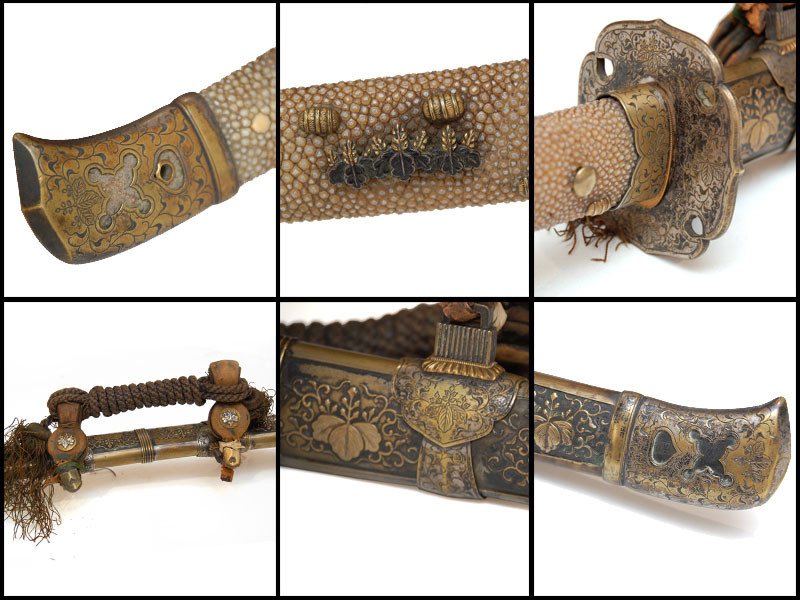




More informations about this product
| Total Weight | 1.536 kg | |
| Weight without Saya | 1.064 kg | |
| Blade Weight | 0.735 kg | |
| Full length Naked Blade (Toshin) |
88.8 cm | |
| Nagasa | 69.1 cm | |
| Tsuka Length | 27.5 cm | |
| Sori (curvature) | 1.92 cm | |
| Kissaki Length | 3.78 cm | |
| Moto Haba | 2.95 cm | |
| Saki Haba | 1.85 cm | |
| Moto Kasane | A = 0.68 cm B = 0.70 cm |
|
| Saki Kasane | A = 0.50 cm B = 0.52 cm |
|
| Curvature | Koshi-zori (Curvature on the first third of the blade) |
|
| Type Kissaki | O Kissaki (Long) | |
| Blade Structure | Shinogi zukuri (diamond shaped) | |
| Mune | Iori mune (Triangular) | |
| Hamon | Hamon gunome Togari Ba type Hyotan (Peaks in series of 2) | |
| Hada | Ko Masame/Itame | |
| Boshi | O-Maru | |
| Nakago | 19.8 cm length. Ubu (unlatered) Signed Tachi Mei «井上眞改 » (Inoue Shinkai) Gimei. Ichimonji Gata shape. End in Ha Agari Kurijiri. Kesho Yasurime type. 1 Mekugi Ana. | |
| Saya | Weight 0.469 kg, 77,8 cm lenght, inside in Magnolia covered with a Tachi gilt bronze assembly, with 7 Semegane, 1 Shibabiki, Amaoi on the whole length, Gilted Ishizuki and Koiguchi, 2 Obi tori. Along with its Bélière, which is OOO. The whole has repeated motives of Paulownia leaves and edgings, along with the « Go San Kirimon » emblem, wich is nowadays linked to the Ministry of Justice and the Imperial Guards Headquarters. « Go San No Kirimon » is 3 Paulownia leaves downside oriented with 3 Paulownia wreath, with 3-5-3 flowers. | |
| Tsuka & Tosogu (Tsuba, Menuki, Fuchi Kashira) |
- Tsuka: 27.5cm length, 134g weight, Hoso Tachi mounting without any braiding. Full Same of high quality, presence of Tawara Byo (2 missings), Kashira and Fuchi in Bronze with the same motives avec the Saya's Koiguchi and Ishizuki. - Menuki: visible Menuki, Triple "Go-Shichi-Kiriomon" motive. It is the Paulownia pattern with a 5-7-5 flower set. It is Toyotomi clan emblem and nowadays the Japan's Government seal. - Habaki: In copper without any relief (Muji) - Seppa: 16 g, 3 Seppa, 2 serrated in gilt (2x6g) and 1 in Copper (4g) - Tsuba: Size 7.7 x 8.4 x 0.42 cm. Weight 156g, Mokko Gata shape. Same drawings as the Saya and Tsuka, edgings leaves and Kirimon with 4 openings in boar's eye shape (Inome). |
|
| Study & Team Review |
Study: Hoso Tachi / Efu no Tachi : These kind of mounting is ceremonial (Gijo no Tachi) which are used from the Heian to the Showa period. Initially, the Hoso Tachi was a ceremonial variation amongst the most affordable, compared to the Kaza Tachi for exemple, and he was often worn by the Court's lesser ranks of nobility. Then the Hoso Tachi was more and more worn by Samurai and higher ranks of the Court. Mostly used for ceremonies, the Hoso Tachi mountings seems quite luxurious, with many ornaments, and often the blades used are 'non-functional' ones, and not very handy for fighting. These mountings are characterized by the Tachi mounting, edge downwards, Bélière to strap it to the belt, and mostly with the lack of braiding on the Tsuka (handle). They are often assembled with a particular Tsuba, like the Shitogi or Kara Tsuba, like the ancient chinese swords. Inoue Shinkai 井上眞改, Osaka Kunisada school : This blade is signed Inoue Shinkai, but it is a forged signature. The strokes and some alignments don't match to the original signatures. The steel used doesn't match the reputation and the work of Inoue Shinkai. Inoue Shinkai(井上眞改), born in 1630 with the civil name of Inoue Hachirobei, was the second son of the first generation "Izumi no Kami Kunisada" (和泉守国貞). At his beginnings, and for 20 years, he used and signed the same name as his father, Kunisada. He then succeeded his father as the second generation of Kunisada and also was entitled "Izumi no Kami" in 1652. The son became as famous as his father's, and was amongst the best smith in Osaka, and amongst the elite of the swordsmiths of the Shinto period. He was even granded the nickname of "Osaka's Masamune". In 1661, after presenting a sword to the Imperial court, he was granted the right to affix the chrysanthemum's imperial emblem (Kikumon) on his signings. Circa 1672, he became a laic priest and begin to sign as "Inoue Shinkai". He died brutally in 1682, aged only of 52. So there was to steps in the evolution and perfection of Inoue Shinkai's productions. First stage was when learning under his father Kunisada. Second stage was after his father's death and his title "Izumi no Kami", by perfecting and seeking his own style. Then the last stage, under the name of Inoue Shinkai, producing masterpieces nowadays classified as "important cultural objects and goods" Team Review : Still in it original condition, blade with oxydation traces, blunted edge. Koshirae in general good shape, Bélière ties are defective, 2 Tawara Byo are missing on the handle. Rare set of ceremony, even with Gimei blade, and with a mounting not very usable on the battlefield. It is an artefact related to Japanese customs and the imperial court. |
|
Share your opinion
error Your review appreciation cannot be sent
feedback Report comment
check_circle Report sent
error Your report cannot be sent